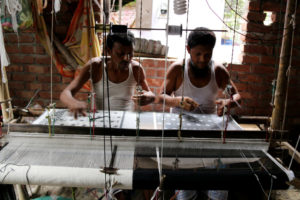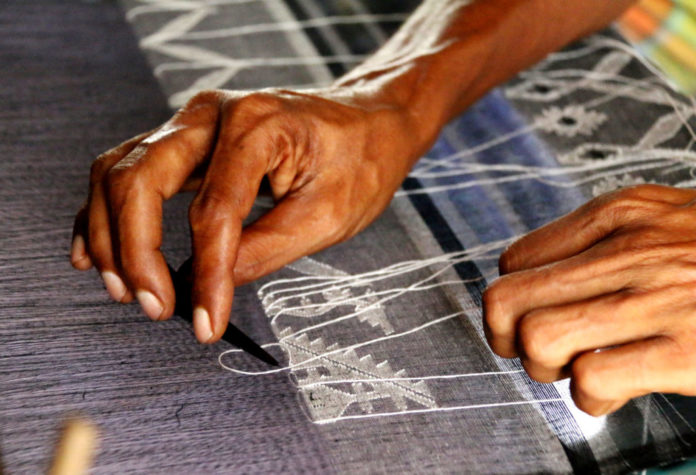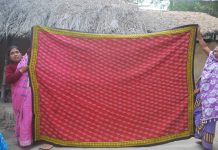Jamdani, the loom figured muslin, was the chef d’oeuvre of the Dhaka loom. The name was derived from the Persian word jam-dar meaning flowered or embossed. From the Mahabharat to the records of Pliny, Megasthenes and Abul Fazl’s Ain i Akbari, history is replete with references to the outstanding quality of the muslin of the sub-continent and its dominance over world trade. The unrivalled quality of Dhaka’s muslin was attributable to three important factors—photee, a superior cotton (gossypium herbaceum), which grew along the banks of the Meghna; the exceptional fineness of handspun yarn and finally, the skill of the weavers. It was this indigenous cotton which created the finest muslin, and later Jamdani, thereby remaining unique to Dhaka and its environs. Presently, jamdanis are woven in Sonargaon, Dakhin Ruposhi, Noapara, Tarabo and Siddhirgunj.
 Jamdani weaving uses discontinuous supplementary weft technique, as in brocade. The jamdani loom along with pre-weaving processes and weaving techniques have remained the same as in earlier times. Cotton yarn is starched, wound and dried on cylindrical bamboo frames. Warp, weft and design yarns are rolled on various sizes of bobbins. Warp yarn is inserted individually into comb-like dents of the bamboo reed and set on to the loom. Silk warps, highlighted with gold or silver threads, are used sometimes to create a gauze like texture. Most of the preparatory work is done by women; they have recently taken up weaving as well. Today memorised instructions known as buli have replaced by paper patterns; traditionally weaving masters instruct their apprentices orally to weave the patterns together
Jamdani weaving uses discontinuous supplementary weft technique, as in brocade. The jamdani loom along with pre-weaving processes and weaving techniques have remained the same as in earlier times. Cotton yarn is starched, wound and dried on cylindrical bamboo frames. Warp, weft and design yarns are rolled on various sizes of bobbins. Warp yarn is inserted individually into comb-like dents of the bamboo reed and set on to the loom. Silk warps, highlighted with gold or silver threads, are used sometimes to create a gauze like texture. Most of the preparatory work is done by women; they have recently taken up weaving as well. Today memorised instructions known as buli have replaced by paper patterns; traditionally weaving masters instruct their apprentices orally to weave the patterns together
The remarkable range and diversity of designs set jamdanis apart from all other muslins. According to George Watt, Percy Brown and other historians, Jamdani patterns were of Persian origin. Under Mughal patronage, Persian weavers worked with indigenous counterparts and created the finest woven patterns in jamdanis. It is this exquisite design element which makes jamdani unique to Bangladesh. It is in a thriving condition.
Bibliography
Ahmed, Tofail. Amader Pracheen Shilpa. ( Bengali ). Bangla Academy, Dacca 1964.
Ashmore, Sonia. Muslin. London 2012
Askari, Nasreen and Rosemary Crill. Colours of the Indus. London 1997.
Baines, Edward. A History of the Cotton Manufacture in Great Britain. Fisher, Fisher and Jackson, 1935.
Banerjee, N. N. Monograph on the Cotton Fabrics of Bengal. Calcutta 1898.
Barnes, Ruth and Cohen, Steven, Crill, Rosemary. Trade, Temple and Court. India 23
Bhowmick, A. K. Traditional Textiles of Bengal. Calcutta, undated.
Birdwood, G. Report on the Old Records of the India Office. London 1891.
Chattopadhyay, Kamaladevi. Handicrafts of India. Delhi 1975.
Crill, Rosemary. Indian Embroidery. London 1999.
Crill, Rosemary. Textiles from India. 2005.
Deb, Chitra. Kimbadantir Muslin. ( Bengali ). Calcutta 1982.
Ganguli, Kalyan Kumar. Designs in Traditional Arts of Bengal. Calcutta 1963.
Ghose, Ajit. “Figured Fabrics of Bengal”. Marg, Vol 111, No 1. Bombay 1948.
Ghuznavi, Sayyada R. Naksha: A Collection of Designs of Bangladesh. Dhaka 1981.
Ghuznavi. Sayyada. R. “Jamdani”, in. Woven Air . Whitechapel Gallery. London. 1988
Ghuznavi, Ruby. “Muslins of Bengal”, Textiles from India, 2005.
Ghuznavi, Sayyada R. “Jamdani The Legend and Legacy”.Textile Traditions of Bangladesh. NCCB. Dhaka 2006.
Haque, Enamul. Islamic Art Heritage of Bangladesh. Dhaka 1983.
Hossain, Hameeda. The Company Weavers of Bengal. Delhi 1988.
Hossain, Hameeda. “Textile Purchases of the East India Company”. Woven Air, Whitechapel Gallery 1988.
Hossain, Hameeda. “Trade Links with the Commonwealth”. Crafts of Bangladesh. NCCB.1987.
Islam, Saiful. Muslin! My Story. Drik. Dhaka 2016.
Karim, Abdul. Dhakai Muslin.( Bengali ). Bangla Academy. Dacca 1975.
Mitra, D.B. Cotton Weavers of Bengal. Calcutta 1978.
Saidur, Mohammad. Jamdani. ( Bengali ) Bangla Academy. Dhaka 1993.
Sangat, S.P. “Indian Muslins of the 17th Century”. Purba Vol IV, No 1. April 1973.
Sinha, J.C. “The Dacca Muslin Industry”. The Modern Review. April 1925.
Taylor, James. Cotton Manufactures of Dacca. London 1851
Watson, John Forbes. The Textile Manufactures and Costumes of the People of India. London 1866.
Watt, Sir George. Indian Art at Delhi, 1903.. Calcutta 1903.





